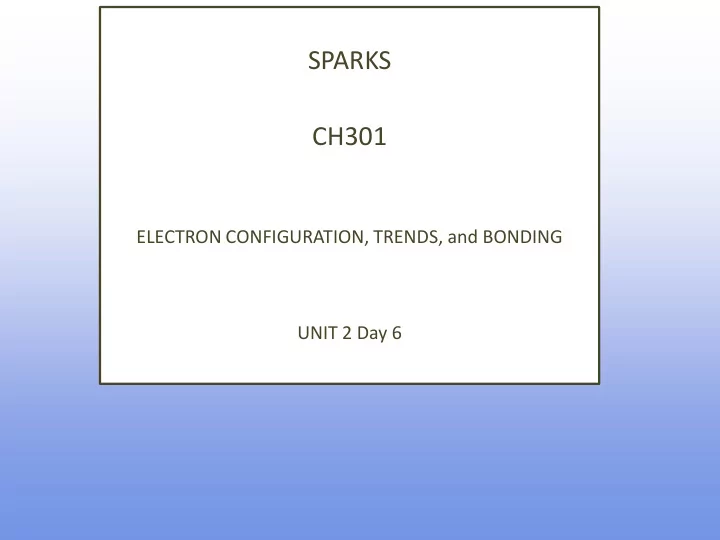

SPARKS CH301 ELECTRON CONFIGURATION, TRENDS, and BONDING UNIT 2 Day 6
Important Information Assigned: - LM18 and HW 11 - Study these topics in fundamentals in eBook: Ionic and Covalent Bonding Nomenclature Know name/symbols for elements through #92 - Nomenclature quiz Monday. Non-graded LM that may be useful for study: - Laude LM Lectures 5, 6, 7 - NGM10 – covalent nomenclature - NGLM11 ionic nomenclature - NGLM07 Periodic Table Basics
INDIVIDUAL QUIZ: NO TALKING! The trend on the periodic table is that atomic radii: a) Increases as you move from L to R across b) Decreases as you move from R to L across c) Increases as you move from T to B down d) Increases as you move from B to T up e) Both b and c
INDIVIDUAL QUIZ: NO TALKING! The trend on the periodic table is that ionization energy increases as you move a) from L to R across and from T to B down. b) from R to L across and from T to B down. c) from L to R across and from B to T up. d) from R to L across and from B to T up. e) From L to R across and does not change as you move from T to B.
What are we going to learn today? − Electron Configuration, Trends, and Bonding • Relate the valence shell electron configuration to ionization energy • Relate the valence shell electron configuration to bonding • Understand the similarities and differences between ionic and covalent bonding • Recognize and name compounds based on elemental composition
IONIZATION ENERGY
He 2500 Ne 2000 F Ar N 1500 Cl Ionization C P O H Be Energy 1000 Si Mg Ca (kJ/mol) S B 500 Al Li Na K 0 1 2 3 4 5 6 7 8 9 10 11 12 13 14 15 16 17 18 19 20 7 Atomic Number
Based on this trend in ionization energies this element is A. argon B. carbon C. magnesium D. sulfur
Trends provide useful information! Why can Sr be dangerous? • What biologically important element would you expect it to be chemically similar to?
Where are the electrons in Ne? 1s 2 2s 2 2p 6 very stable gas Z=10 Where are the electrons in Na? [Ne]3s 1 not so stable metal Z=11 Where are the electrons in K? [Ar]4s 1 not so stable metal Z=19 Easier or harder to ionize than Na?
ELECTRON LEAVES.. WHERE DOES IT GO? Metals tend to give up electrons to nonmetals, in each case the valence is “ satisfied ” Sometimes is complicated… eg in the sodium in water demo Sometimes is more obvious… 2Na(s) + Cl 2 (g) 2NaCl(s) Sometimes they are already gone!
Formation of Ionic Compound – Downhill in Energy IE Li = 520 kJ/mol Electron Affinity of fluorine o E change when a gas phase atom gains an electron. o = EA F = -328 kJ/mol o Note that net energy change is still positive – less stable! Why does LiF form?
The structure of lithium fluoride
Ionic Compound… downhill in energy…..
Ionic Compounds… Not a discrete pair of ions…it is a whole collection
POLL: CLICKER QUESTION Coulomb ’ s Law Lattice energy depends on Coulomb ’ s Law and the crystal structure (the way the ions are packed together). Assuming the same crystal structure, which do you think would have the larger lattice energy: a)NaF b)NaBr?
Ionic Radius
What is your expectation of the lattice energy for MgO – large or small?
POLL: CLICKER QUESTION Which would have the larger lattice energy? A. CaS B. NaCl
Polyatomic Ions Calcium Carbonate Ca 2+ 2- CO 3 Know the names and formulas for all the common polyatomic ions. See the Data & Tables under “ more ” on the eBook
POLL: CLICKER QUESTION Naming Ionic Compounds Choose the formula that corresponds to: sodium oxide a)NaO b)NaO 2 c)Na 2 O d)Na 2 O 2
Naming Ionic Compounds You need to be able to name common ionic compounds and with elemental ions and polyatomic ions. WEBSITE – FUNDAMENTALS – DO THE WORKSHEETS
What have we learned? NUCLEAR CHARGE FELT BY VALENCE ELECTRONS IS SHIELDED BY THE CORE ELECTRONS ATOMS BEHAVE IN CERTAIN PREDICTABLE WAYS WHICH CAN BE CORRELATED TO THE ELECTRON CONFIGURATIONS IONIC BONDS TEND TO FORM BETWEEN METALS AND NONMETALS COVALENT BONDS TEND TO FORM BETWEEN NONMETALS AND NONMETALS NAMING COMPOUNDS IS IMPORTANT AND NECESSARY
Learning Outcomes Identify metals and non-metals and predict types of compounds (ionic/covalent) Between different elements Relate coulombs law and lattice energy Name basic binary ionic compounds including polyatomic ions
Recommend
More recommend